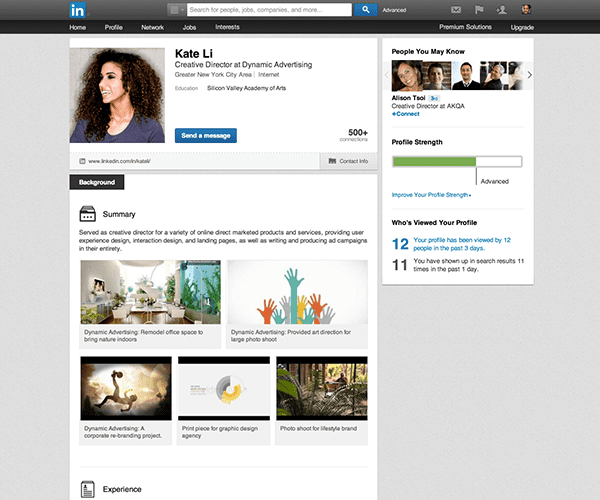I have a confession: for years I have avoided LinkedIn like the plague. My first experience with the social network was relatively early in its existence and I did not enjoy it.
I joined LinkedIn because an employer needed me to manage the company account and (at the time) I didn’t know much about it. Right off the bat, I hated it.
The profile nags and premium service upsells drove me nuts. The fact that you could not easily dismiss notifications made me angry. The droves of people sending me oily messages about how awesome they are (and how they want me to tell others about how awesome they are) made me gag. And finally, the constant barrage of LinkedIn related email drove me to the brink.
I attempted to both delete my account and unsubscribe from all emails–neither of which, at that early date, seemed to be possible. Unsubscribe be damned, apparently. And so, I chose to ignore my LinkedIn account.
For years I refused to maintain it. I set up filters to deal with all those annoying emails and sanguinely forgot all about it. Until (relatively) recently that is.
I can’t say for sure what prompted me to log back in and see how things had evolved over the intervening years, but I did. And surprisingly, I liked what I saw.

The profile nags were still there, but less intrusive and with a design that made them easier on the eye (and therefore, more bearable). My notifications had piled up a little, but what’s 1,000+ unread messages between friends, right?
Overall, I saw that the platform had grown up in a lot of ways. Most importantly, for a user like myself anyways, it had gotten out of its own way. The central concept of LinkedIn has always been a great one. A professional social network for business networking, hiring, and more. In theory, any professional should want to be a part of it. But for many, myself included, that hasn’t always been the case.
Thankfully, the era of LinkedIn that drove me away seems to be gone. And it probably has been for quite some time. Knowing it for myself though has inspired me to take a new and deeper look at it as a tool for marketing myself, my business/brand, and my content. This post is the result of that research and tinkering. I hope find it as valuable as I have recently.
- 1 Why Use LinkedIn for Marketing?
-
2
LinkedIn Marketing Best Practices
- 2.1 Complete Your Personal Profile and/or Company Page (And Keep It Current!)
- 2.2 Connect to Your Website & Other Social Channels
- 2.3 Participate In (And Organize) Groups
- 2.4 Don’t Ignore Others’ Engagement
- 2.5 Don’t Be Annoying (Try Listening Instead)
- 2.6 Be Genuine
- 2.7 Seek Recommendations Tactfully & Give Them When They’re Deserved
- 2.8 Create & Share the Right Content
- 2.9 Set Goals, Measure Results, & Make Appropriate Changes
- 3 In Conclusion
Why Use LinkedIn for Marketing?

With all of the other options for marketers out there, there really is a point in time where you have to ask yourself, “how much is too much?”
It doesn’t do you any good to have an account on a network you don’t use and are obviously inactive on. So choosing to extend yourself across another platform is a big choice and should be made for the right reasons.
For me, it has come down to recognizing what LinkedIn is better at than any other network/platform and deciding whether or not those things are going to directly benefit me in the near future.
Such as…
Business Development
LinkedIn is perfect for developing business to business relationships. In fact, that was the first thing I ever used the platform for and based on the leads and relationships generated from that experience I was able to nurture and grow a significant revenue stream for my company.
Establishing Thought Leadership
Because LinkedIn is literally all about business, all those lessons and insights you gain while slaving away day after day actually become quite valuable. By using the provided tools you can write them out, share them with precisely the groups that want or need them, and gain the reputation your ideas deserve.
Boosting Your Content Reach
While LinkedIn is not as big of a firehose as Facebook or Twitter, its feed is similar and can still propel content into viral territory. Perhaps more importantly, because of the focused nature of the network, it’s easier to match your content to the interests of those coming across it. So even if your readership on the network is less than it might be elsewhere there is a good chance these engagements are more valuable.
Relevant Community Groups
Similarly to Reddit and Google+, the community groups on LinkedIn are active and topically focused. They provide anyone in them with a great “neutral” place to contribute to the community, share content, and provide thought leadership.
And (Of Course) Increasing Professional Visibility
Just having a fully filled out LinkedIn account that’s kept current (which is probably the least you can afford to do and still get positive result) will boost your visibility with potential clients, employers, partners, and employees.
LinkedIn Marketing Best Practices

After reading my introduction to this post it’s probably fair for you to wonder how valid my advice in the following section really is. To which I say, fair enough. However, I am not the inventor or discoverer of the best practices I’ve listed below. Rather these are the result of a fair amount of research into what has worked for other people. All I can say is that since I’ve (re)applied them on my account, I’ve seen positive results too. So let’s get into it!
Complete Your Personal Profile and/or Company Page (And Keep It Current!)
Aside from simply keeping the profile nags at bay, the process of fully completing your personal profile and/or company page cannot be underestimated. You’ll not only want to fill in all of the appropriate blanks, but refine your copy and go the extra distance to make a great presentation. Including actually making a presentation. Which is a handy feature you can take advantage of to embed a document, photo, link, video, or presentation on your profile.
While it’s true that LinkedIn provides all of the tools necessary to contact those you’re connected with or interested in being connected with, it’s probably a good idea to add links to your website and other relevant social sites.
Participate In (And Organize) Groups
This is a big one. LinkedIn groups are one of its most popular features. Joining or starting a popular group has literally made all the difference for some companies/individuals. Be sure that if you start a group you actually have the knowledge and clout to maintain leadership of it. And if you join a group be sure to play by the rules and offer as much value as you possibly can.
Don’t Ignore Others’ Engagement
If someone is being a troll or attention monger then yeah, ignore them. But if someone is engaging with you, a group your involved in, or your content–don’t ignore them. You know, be social.
Don’t Be Annoying (Try Listening Instead)
Just like in real world relationships and conversations, being annoying won’t do you any favors. Probably the easiest way to come off as annoying on LinkedIn is to ask for too much, give too little, and not really know anyone. Instead, especially if you are new to the platform, listen to the conversations others are trying to have. Jump in when appropriate and provide value. Build on that and be patient.
Be Genuine
We all like watching guys like Saul Goodman from Breaking Bad (“Better Call Saul!”). But if you write introductory messages, comments, or profile copy like his commercials then you’re probably going to be avoided by others. It’s just not genuine or likable. Instead, drop the “showmanship” and let your genuine passion for what you do inspire the voice you use on LinkedIn.
Seek Recommendations Tactfully & Give Them When They’re Deserved
Imagine this: a new guy is hired at your office. The first thing he does it run from desk to desk and room to room, popping up when least expected, saying, “Would you recommend me?”
It’s weird, right? (Yes, in case you were wondering.)
So what makes people think it’s not weird online baffles me. Personally, I tend to do my best to extend the same level of tactfulness to my LinkedIn “asks” that I would for a letter of recommendation from a boss, friend, or coworker in the physical world. It seems to work much better than manically shotgunning “cold emails” out to everyone in my extended network.
Don’t share everything you post or publish elsewhere via automated tools/plugins. Less frequent but higher quality content seems to go over best on LinkedIn. So manually share the content you create elsewhere that’s relevant and take the time to occasionally create something just for LinkedIn. Which is actually a great place for creating meaningful articles. They offer a beautiful posting feature that feels very similar to writing a blog post in WordPress. Take advantage of it!
Set Goals, Measure Results, & Make Appropriate Changes
As is the case with all strategic plans, from time to time you’ll need to set goals, measure your success (or failure), and make the appropriate changes to what you’re doing on LinkedIn. I don’t think that means you have to completely redefine what you’re doing each time you step back to reflect, instead try to make small changes one at a time until everything is going in the right direction.
In Conclusion
LinkedIn has always been a great platform for connecting with other professionals in meaningful ways. The best practices in this post should go a long way towards helping anyone serious about getting the most out of it.
That said, I’m sure there are quite a few readers here with a lot of valuable experience on LinkedIn and I’m sure the whole community would love to read about how your experience lines up with the practices I’ve outlined above. Or, for that matter, if you have more to add. In either case, please take a minute or two to share your story with us in the comments section below.
Article Thumbnail via mayrum // shutterstock.com









That’s what is important to understand that the Internet operates on the same principles as real life. There is no difference, because both, online and offline, are the same people.
Hi Nathan,
Great article here, and thank you very much for your article here. So, from now on I can implement this method that you explain here to my LinkedIn site and hope the result will come as good as I targeted.
Thanks again, Nathan.
Hi Nathan. I recently wrote a blog post on LinkedIn Etiquette and was surprised to find comments from visitors telling me that they were not active on LInkedIn and one Tweeter said she stayed away from LinkedIn for security reasons!
I found myself suggesting to them to give LinkedIn a shot to nurture their business leads and pointed out that LinkedIn profiles appear in the Top 3 results in a Google search. That in itself should be good motivation to be active on LinkedIn since people do Google your name before considering engaging in business.
Hi Nathan,
As with all social media, I have seen the changes to Linkedin as well. From a business point of view, it is the perfect platform to learn from other business people what is new and current in your industry and by all means contribute your experience and knowledge through the blogging platform Linkedin provides. If you are so inclined, it is a great way to put your resume out there and attract the right people who may be able to help you.
Hi everyone,
i gotta say, in my experience LinkedIn groups are still cluttered with marketing. The same goes for discussion attempts – some conversational inputs (and they’re not few) feel like ad-breaks.
the new content flow in the timeline is quite interesting, but i never had the pelasure to find a group I really kept wanting to belong to.
Thanks Nathan,
I am trying to apply your suggestions in a “Personal Profile and Company Page”.
My personal profile is doing well, but I find it diffucult to get followers on the Company page. Can I link my connections from the personal profile to the company. Or is there another way get more followers of the company page?
Do you think its ok to send a message to someone who is connected with you on linkedin to introduce your services?
I hear a lot of people talking about “goal setting” for their social media and social media marketing. Give me some goal examples, how they were achieved. (perhaps this a post for another day). Most, if not all of my results are purely organic, random. Even though I keep an up-to-date LinkedIn profile and a company page, do best practices, post my own content and others, rarely do I get quality leads directly from LinkedIn. I have to meet the person in real life first, then connect on LinkedIn and build a relationship online and off. From there and over time, I’ll get quality referrals, leads, asked to collaborate on projects, but it’s a very long tail.